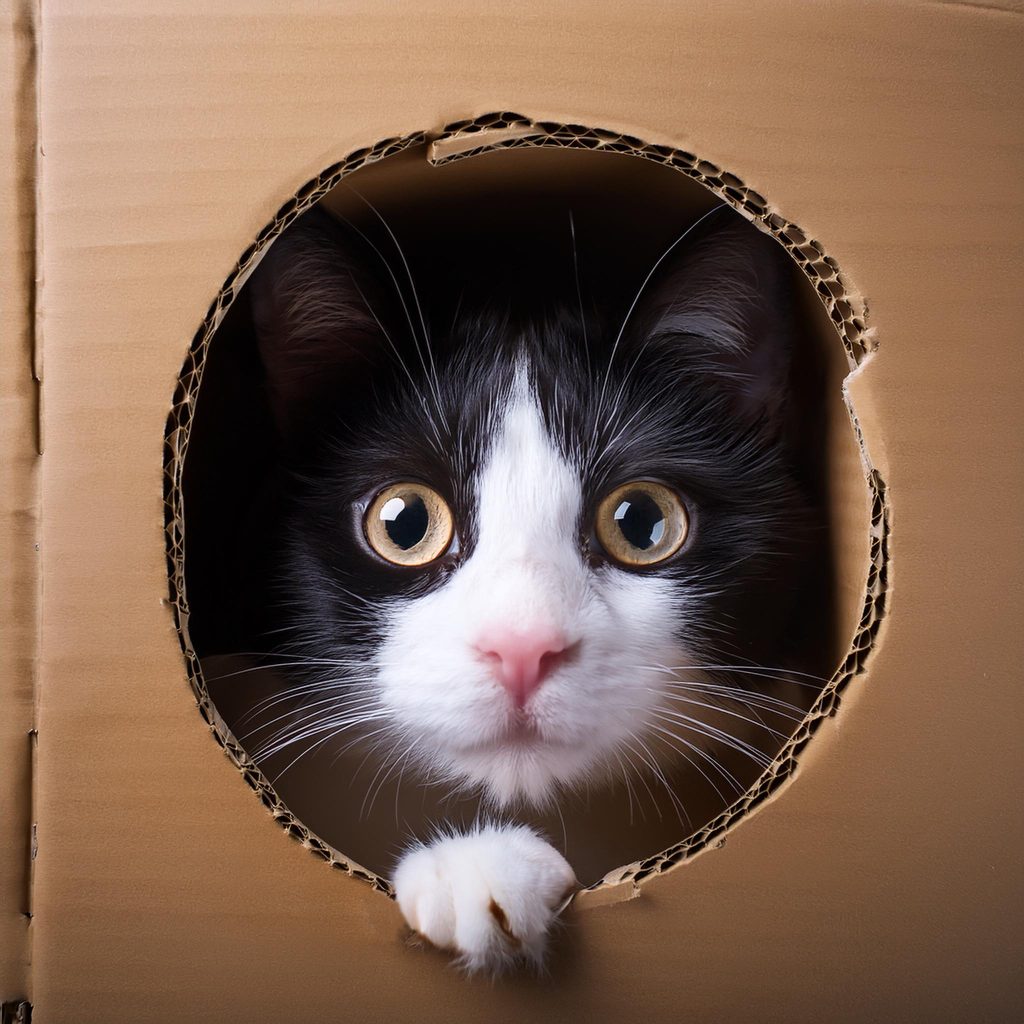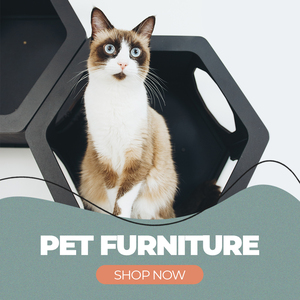Have you ever bought a fancy new cat toy, only to find your furry friend more interested in the box it came in? Yep, you’re not alone. The mysterious allure of cardboard boxes to our kitty companions has puzzled and amused cat owners for generations. Join us as we embark on a whisker-twitching journey to uncover the secrets behind this cardboard conundrum.
The Feline Fort
Picture this: You’re a small, furry predator in a world of giants. Suddenly, you stumble upon a perfect hideout with sturdy walls, a cozy interior, and just enough space to curl up in or spring from unseen. That’s exactly what a box represents to your cat. It’s not just a discarded Amazon package, it’s a feline fort of solitude.
The Hunter’s Hideout
Let’s face it, your adorable ball of fluff is a born predator. Those cute little paws? Designed for stalking and latching onto prey. Those big, innocent eyes? Perfect for spotting the tiniest movement, even in low light. And that box? It’s the ideal vantage point for planning their next attack on the unsuspecting dust bunny across the room.
Boxes tap into your cat’s instinctual behavior as a hunter. In the wild, cats are ambush predators, preferring to hide and pounce rather than chase down their prey in an all-out sprint. Cardboard boxes provide the perfect cover for your little lion to observe their prey, be it a toy mouse or your unsuspecting ankle.

So the next time you see your cat crouched in a box, eyes wide and tail twitching, know that you’re witnessing thousands of years of evolutionary instinct at work. Just be prepared for furious action when you least expect it.
The Purr-fect Safe Space
We all want a place to disappear to when the world gets a bit too overwhelming, and cats are no exception. To your feline friend, cardboard boxes aren’t just boxes, they’re a way to escape the chaos of the human world (like that terrifying vacuum cleaner or the dreaded nail trimmer).
Studies have shown that cats who are provided with hiding spaces tend to be less stressed and more comfortable in their environment. It’s like having their own personal panic room, but cozier and cardboard-scented.
This desire for a safe space is especially important for cats in new environments. So, if you’ve just moved or brought home a new kitty, don’t be surprised if they make a beeline for the nearest box. It’s not that they don’t appreciate your carefully chosen bougie cat bed — right now they just want an enclosed space to help them adjust.
The Feline Thermostat
Did you know that cats have a higher body temperature than humans? Their ideal environmental temperature is between 86 and 97 degrees Fahrenheit. That’s why you’ll often find your cat sprawled out in the sunniest spot in the house or curled up near a heat vent.
Cardboard boxes are simple structures, yet surprisingly good insulators that help your cat maintain their preferred body temperature. It’s their personal sauna! Minus the awkward small talk with strangers in towels. Nobody wants that.
So the next time you see your cat squeezed into a box that looks way too small for comfort, remember — they’re not just being quirky, they’re being thermally efficient.
The Kitty Playground
When cats look bored, there’s a good chance that they ARE bored. They need mental and physical stimulation to keep them happy and healthy. And while you might see simple cardboard boxes, your cat sees a world of possibilities. A box can be a scratching post (your couch will thank you), a chew toy, a jungle gym, and a nap pod to rest up for their next 18-hour sleep sesh.
Each new box that enters your home is a novel object for your cat to explore, conquer, and ultimately claim as their own. It’s Christmas morning every time the delivery person drops off a package!
The Mystery of the Tape Square
Now, you might be thinking, “Okay, I get cardboard boxes, but what about those viral videos of cats sitting in tape squares on the floor? There’s no way that’s providing security or warmth.”
You’re right, astute observer — give yourself a salmon treat! The tape square phenomenon is a bit different, but equally fascinating. Here’s why your cat might be drawn to these two-dimensional boxes:
Territorial Tattoos
Cats are territorial creatures. They like to mark their space and investigate new boundaries. When you put tape on the floor in a square shape, you’re essentially creating a new territory in their environment. It’s like you’ve drawn a treasure map, and X marks the spot where your cat must sit.
Paws to Investigate
Cats are naturally curious creatures. Anything new in their environment is bound to catch their attention. That tape outline on the floor is the feline equivalent of a crop circle — mysterious, intriguing, and definitely worth checking out.
The Power of Illusion
Here’s where it gets really interesting. That tape outline might be creating the illusion of a contained space, triggering the same behaviors that actual cardboard boxes do. Your cat might perceive it as a defined, safe area to sit in, despite the lack of physical barriers. If they’re playing an elaborate game of make-believe, who are we to spoil their fun?
Box of Benefits: Why This Quirk Is Actually Good for Your Cat
Now that we’ve unraveled the mystery of the cat’s love affair with cardboard boxes, you might be wondering if this behavior is actually beneficial for your feline friend. The answer is a resounding “yes!”
Stress Relief
Remember how we mentioned that boxes provide a sense of security? This can be incredibly helpful in reducing stress for your cat. Whether they’re dealing with changes in their environment, new family members (human or furry), or just the general anxiety of being a cat in a dog’s world, having a safe space to retreat to can make a big difference.
Exercise and Play
Cardboard boxes encourage play behaviors, which are crucial for your cat’s physical and mental health. All that jumping in and out, scratching, and pouncing is great exercise. Think of it as kitty CrossFit with purring instead of grunting.
Mental Stimulation
Boredom can lead to destructive behaviors in cats. By providing cardboard boxes for exploration and play, you’re giving your cat some much-needed mental stimulation. It’s a puzzle toy they can snooze in once they’ve solved it.
Temperature Regulation
As we said earlier, boxes can help your cat maintain their ideal body temperature. This is particularly important for older cats or those with health issues who might have trouble regulating their body heat.
Embracing the Box: Tips for Cat Owners
Okay, now that you understand why your cat is so obsessed with boxes, here are some ways you can use this knowledge to enrich your four-footed friend’s life:
Keep the Boxes Coming
Don’t be too quick to recycle those shipping boxes. Your cat will appreciate having a variety of boxes to explore, even if they all seem about the same to you. Just be sure to remove any staples or tape, and don’t share any cardboard boxes that might have soaked up something potentially harmful.
Create a Kitty Condo
Tap into your imagination and make a multi-level cat palace out of cardboard boxes. It’s so easy to build a modular setup with ordinary scissors or a utility knife. You can cut holes between boxes to create tunnels and hideaways and build a cat-sized obstacle course — no engineers, architects, or permits needed!
Rotate the Boxes
To keep things interesting for your furry roommate, switch out the boxes every few weeks. It’s like redecorating, but much cheaper, and far easier than dealing with contractors.
Box + Toy = Bliss
Try hiding treats or toys in cardboard boxes to create extra-engaging play experiences and treasure hunts for your favorite furball.
Respect the Box
If your cat has claimed a box as their safe space, try to be sensitive to that. Don’t force them out of their box or use it as a way to trick them into unpleasant experiences (like vet visits). You want cardboard boxes to remain a positive, safe space in their mind.
Conclusion: Think Inside the Box
So there you have it — the powerful draw of the humble box explained. From satisfying primal instincts to providing comfort and entertainment, cardboard boxes play a surprisingly important role in our cats’ lives.
The next time you see your cat squeezing into a box that seems far too small, or sitting proudly in a tape square on the floor, remember — they’re not just being silly, they’re embracing their natural instincts, seeking comfort, and finding joy in the little things.
Perhaps we humans could learn a thing or two from our box-loving companions. After all, in a noisy world full of complexity and overstimulation, isn’t there something appealing about finding contentment in a quietly simple cube?
So, embrace your cat’s obsession with cardboard boxes. Save that next delivery box and see how much it adds to your feline friend’s life. And maybe you’ll find yourself making a human-sized box of your own.

Your blog is a constant source of inspiration for me. Your passion for your subject matter is palpable, and it’s clear that you pour your heart and soul into every post. Keep up the incredible work!
“Mind = blown! 🌟 This is exactly the comprehensive breakdown I needed. Your expertise shines through in every paragraph. Thanks for sharing such well-researched content.”